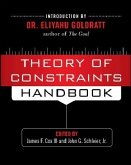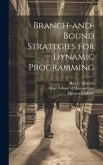The Handbook of Multilevel Theory, Measurement, and Analysis
Herausgeber: Humphrey, Stephen E.; Lebreton, James M.
The Handbook of Multilevel Theory, Measurement, and Analysis
Herausgeber: Humphrey, Stephen E.; Lebreton, James M.
- Gebundenes Buch
- Merkliste
- Auf die Merkliste
- Bewerten Bewerten
- Teilen
- Produkt teilen
- Produkterinnerung
- Produkterinnerung
This handbook shows scholars how to conduct multilevel research. Chapters discuss the importance of context, dynamics, and complexity, and guide readers through the nuances of research design and analysis
Andere Kunden interessierten sich auch für
![Smarter Faster Better Smarter Faster Better]() Charles DuhiggSmarter Faster Better8,99 €
Charles DuhiggSmarter Faster Better8,99 €![Instant Networking Instant Networking]() Stefan ThomasInstant Networking17,99 €
Stefan ThomasInstant Networking17,99 €![Theory of Constraints Handbook Theory of Constraints Handbook]() James F CoxTheory of Constraints Handbook132,99 €
James F CoxTheory of Constraints Handbook132,99 €![Markovian Demand Inventory Models Markovian Demand Inventory Models]() Dirk BeyerMarkovian Demand Inventory Models90,99 €
Dirk BeyerMarkovian Demand Inventory Models90,99 €![The Perfectionist's Handbook The Perfectionist's Handbook]() Jeff SzymanskiThe Perfectionist's Handbook21,99 €
Jeff SzymanskiThe Perfectionist's Handbook21,99 €![Branch-and-bound Strategies for Dynamic Programming Branch-and-bound Strategies for Dynamic Programming]() Thomas L. MorinBranch-and-bound Strategies for Dynamic Programming29,99 €
Thomas L. MorinBranch-and-bound Strategies for Dynamic Programming29,99 €![Business Research Methods Business Research Methods]() Donald R. CooperBusiness Research Methods210,99 €
Donald R. CooperBusiness Research Methods210,99 €-
-
-
This handbook shows scholars how to conduct multilevel research. Chapters discuss the importance of context, dynamics, and complexity, and guide readers through the nuances of research design and analysis
Produktdetails
- Produktdetails
- Verlag: American Psychological Association (APA)
- Seitenzahl: 600
- Erscheinungstermin: 27. November 2018
- Englisch
- Abmessung: 287mm x 217mm x 40mm
- Gewicht: 1705g
- ISBN-13: 9781433830013
- ISBN-10: 1433830019
- Artikelnr.: 53931405
- Herstellerkennzeichnung
- Libri GmbH
- Europaallee 1
- 36244 Bad Hersfeld
- gpsr@libri.de
- Verlag: American Psychological Association (APA)
- Seitenzahl: 600
- Erscheinungstermin: 27. November 2018
- Englisch
- Abmessung: 287mm x 217mm x 40mm
- Gewicht: 1705g
- ISBN-13: 9781433830013
- ISBN-10: 1433830019
- Artikelnr.: 53931405
- Herstellerkennzeichnung
- Libri GmbH
- Europaallee 1
- 36244 Bad Hersfeld
- gpsr@libri.de
Edited by Stephen E. Humphrey and James M. LeBreton
Introduction
Part I: Multilevel Theory
Chapter 1: On Finding Your Level
Stanley M. Gully and Jean M. Phillips
Chapter 2: Contextualizing Context in Organizational Research
Cheri Ostroff
Chapter 3: Ask Not What the Study of Context Can Do for You: Ask What You
Can Do for the Study of Context
Rustin D. Meyer, Katie England, Elnora D. Kelly, Andrew Helbling, MinShuou
Li, and Donna Outten
Chapter 4: The Only Constant Is Change: Expanding Theory by Incorporating
Dynamic Properties Into One’s Models
Matthew A. Cronin and Jeffrey B. Vancouver
Chapter 5: The Means Are the End: Complexity Science in Organizational
Research
Juliet R. Aiken, Paul J. Hanges, and Tiancheng Chen
Chapter 6: The Missing Levels of Microfoundations: A Call for Bottom-Up
Theory and Methods
Robert E. Ployhart and Jonathan Hendricks
Chapter 7: Multilevel Emergence in Work Collectives
John E. Mathieu and Margaret M. Luciano
Chapter 8: Multilevel Thoughts on Social Networks
Daniel J. Brass and Stephen P. Borgatti
Chapter 9: Conceptual Foundations of Multilevel Social Networks
Srikanth Paruchuri, Martin C. Goossen, and Corey Phelps
Part II: Multilevel Measurement and Design
Chapter 10: Introduction to Data Collection in Multilevel Research
Le Zhou, Yifan Song, Valeria Alterman, Yihao Liu, and Mo Wang
Chapter 11: Construct Validation in Multilevel Studies
Andrew T. Jebb, Louis Tay, Vincent Ng, and Sang Woo
Chapter 12: Multilevel Measurement: Agreement, Reliability, and
Nonindependence
Dina V. Krasikova and James M. LeBreton
Chapter 13: Looking Within: An Examination, Combination, and Extension of
Within-Person Methods Across Multiple Levels of Analysis
Daniel J. Beal and Allison S. Gabriel
Chapter 14: Power Analysis for Multilevel Research
Charles A. Scherbaum and Erik Pesner
Chapter 15: Explained Variance Measures for Multilevel Models
David M. LaHuis, Caitlin E. Blackmore, and Kinsey B. Bryant-Lees
Chapter 16: Missing Data in Multilevel Research
Simon Grund, Oliver Lüdtke, and Alexander Robitzsch
Part III: Multilevel Analysis
Chapter 17: A Primer on Multilevel (Random Coefficient) Regression Modeling
Levi K. Shiverdecker and James M. LeBreton
Chapter 18: Dyadic Data Analysis
Andrew P. Knight and Stephen E. Humphrey
Chapter 19: A Primer on Multilevel Structural Modeling: User-Friendly
Guidelines
Robert J. Vandenberg and Hettie A. Richardson
Chapter 20: Moderated Mediation in Multilevel Structural Equation Models:
Decomposing Effects of Race on Math Achievement Within Versus Between High
Schools in the United States
Michael J. Zyphur, Zhen Zhang, Kristopher J. Preacher, and Laura J. Bird
Chapter 21: Anything but Normal: The Challenges, Solutions, and Practical
Considerations of Analyzing Nonnormal Multilevel Data
Miles A. Zachary, Curt B. Moore, and Gary A. Ballinger
Chapter 22: A Temporal Perspective on Emergence: Using Three-Level
Mixed-Effects Models to Track Consensus Emergence in Groups
Jonas W. B. Lang and Paul D. Bliese
Chapter 23: Social Network Effects: Computational Modeling of Network
Contagion and Climate Emergence
Daniel A. Newman and Wei Wang
Part IV. Reflections on Multilevel Research
Chapter 24: Cross-Level Models
Francis J. Yammarino and Janaki Gooty
Chapter 25: Panel Interview: Reflections on Multilevel Theory, Measurement,
and Analysis
Michael E. Hoffman, David Chan, Gilad Chen, Fred Dansereau, Denise
Rousseau, and Benjamin Schneider
Index
About the Editors
Part I: Multilevel Theory
Chapter 1: On Finding Your Level
Stanley M. Gully and Jean M. Phillips
Chapter 2: Contextualizing Context in Organizational Research
Cheri Ostroff
Chapter 3: Ask Not What the Study of Context Can Do for You: Ask What You
Can Do for the Study of Context
Rustin D. Meyer, Katie England, Elnora D. Kelly, Andrew Helbling, MinShuou
Li, and Donna Outten
Chapter 4: The Only Constant Is Change: Expanding Theory by Incorporating
Dynamic Properties Into One’s Models
Matthew A. Cronin and Jeffrey B. Vancouver
Chapter 5: The Means Are the End: Complexity Science in Organizational
Research
Juliet R. Aiken, Paul J. Hanges, and Tiancheng Chen
Chapter 6: The Missing Levels of Microfoundations: A Call for Bottom-Up
Theory and Methods
Robert E. Ployhart and Jonathan Hendricks
Chapter 7: Multilevel Emergence in Work Collectives
John E. Mathieu and Margaret M. Luciano
Chapter 8: Multilevel Thoughts on Social Networks
Daniel J. Brass and Stephen P. Borgatti
Chapter 9: Conceptual Foundations of Multilevel Social Networks
Srikanth Paruchuri, Martin C. Goossen, and Corey Phelps
Part II: Multilevel Measurement and Design
Chapter 10: Introduction to Data Collection in Multilevel Research
Le Zhou, Yifan Song, Valeria Alterman, Yihao Liu, and Mo Wang
Chapter 11: Construct Validation in Multilevel Studies
Andrew T. Jebb, Louis Tay, Vincent Ng, and Sang Woo
Chapter 12: Multilevel Measurement: Agreement, Reliability, and
Nonindependence
Dina V. Krasikova and James M. LeBreton
Chapter 13: Looking Within: An Examination, Combination, and Extension of
Within-Person Methods Across Multiple Levels of Analysis
Daniel J. Beal and Allison S. Gabriel
Chapter 14: Power Analysis for Multilevel Research
Charles A. Scherbaum and Erik Pesner
Chapter 15: Explained Variance Measures for Multilevel Models
David M. LaHuis, Caitlin E. Blackmore, and Kinsey B. Bryant-Lees
Chapter 16: Missing Data in Multilevel Research
Simon Grund, Oliver Lüdtke, and Alexander Robitzsch
Part III: Multilevel Analysis
Chapter 17: A Primer on Multilevel (Random Coefficient) Regression Modeling
Levi K. Shiverdecker and James M. LeBreton
Chapter 18: Dyadic Data Analysis
Andrew P. Knight and Stephen E. Humphrey
Chapter 19: A Primer on Multilevel Structural Modeling: User-Friendly
Guidelines
Robert J. Vandenberg and Hettie A. Richardson
Chapter 20: Moderated Mediation in Multilevel Structural Equation Models:
Decomposing Effects of Race on Math Achievement Within Versus Between High
Schools in the United States
Michael J. Zyphur, Zhen Zhang, Kristopher J. Preacher, and Laura J. Bird
Chapter 21: Anything but Normal: The Challenges, Solutions, and Practical
Considerations of Analyzing Nonnormal Multilevel Data
Miles A. Zachary, Curt B. Moore, and Gary A. Ballinger
Chapter 22: A Temporal Perspective on Emergence: Using Three-Level
Mixed-Effects Models to Track Consensus Emergence in Groups
Jonas W. B. Lang and Paul D. Bliese
Chapter 23: Social Network Effects: Computational Modeling of Network
Contagion and Climate Emergence
Daniel A. Newman and Wei Wang
Part IV. Reflections on Multilevel Research
Chapter 24: Cross-Level Models
Francis J. Yammarino and Janaki Gooty
Chapter 25: Panel Interview: Reflections on Multilevel Theory, Measurement,
and Analysis
Michael E. Hoffman, David Chan, Gilad Chen, Fred Dansereau, Denise
Rousseau, and Benjamin Schneider
Index
About the Editors
Introduction
Part I: Multilevel Theory
Chapter 1: On Finding Your Level
Stanley M. Gully and Jean M. Phillips
Chapter 2: Contextualizing Context in Organizational Research
Cheri Ostroff
Chapter 3: Ask Not What the Study of Context Can Do for You: Ask What You
Can Do for the Study of Context
Rustin D. Meyer, Katie England, Elnora D. Kelly, Andrew Helbling, MinShuou
Li, and Donna Outten
Chapter 4: The Only Constant Is Change: Expanding Theory by Incorporating
Dynamic Properties Into One’s Models
Matthew A. Cronin and Jeffrey B. Vancouver
Chapter 5: The Means Are the End: Complexity Science in Organizational
Research
Juliet R. Aiken, Paul J. Hanges, and Tiancheng Chen
Chapter 6: The Missing Levels of Microfoundations: A Call for Bottom-Up
Theory and Methods
Robert E. Ployhart and Jonathan Hendricks
Chapter 7: Multilevel Emergence in Work Collectives
John E. Mathieu and Margaret M. Luciano
Chapter 8: Multilevel Thoughts on Social Networks
Daniel J. Brass and Stephen P. Borgatti
Chapter 9: Conceptual Foundations of Multilevel Social Networks
Srikanth Paruchuri, Martin C. Goossen, and Corey Phelps
Part II: Multilevel Measurement and Design
Chapter 10: Introduction to Data Collection in Multilevel Research
Le Zhou, Yifan Song, Valeria Alterman, Yihao Liu, and Mo Wang
Chapter 11: Construct Validation in Multilevel Studies
Andrew T. Jebb, Louis Tay, Vincent Ng, and Sang Woo
Chapter 12: Multilevel Measurement: Agreement, Reliability, and
Nonindependence
Dina V. Krasikova and James M. LeBreton
Chapter 13: Looking Within: An Examination, Combination, and Extension of
Within-Person Methods Across Multiple Levels of Analysis
Daniel J. Beal and Allison S. Gabriel
Chapter 14: Power Analysis for Multilevel Research
Charles A. Scherbaum and Erik Pesner
Chapter 15: Explained Variance Measures for Multilevel Models
David M. LaHuis, Caitlin E. Blackmore, and Kinsey B. Bryant-Lees
Chapter 16: Missing Data in Multilevel Research
Simon Grund, Oliver Lüdtke, and Alexander Robitzsch
Part III: Multilevel Analysis
Chapter 17: A Primer on Multilevel (Random Coefficient) Regression Modeling
Levi K. Shiverdecker and James M. LeBreton
Chapter 18: Dyadic Data Analysis
Andrew P. Knight and Stephen E. Humphrey
Chapter 19: A Primer on Multilevel Structural Modeling: User-Friendly
Guidelines
Robert J. Vandenberg and Hettie A. Richardson
Chapter 20: Moderated Mediation in Multilevel Structural Equation Models:
Decomposing Effects of Race on Math Achievement Within Versus Between High
Schools in the United States
Michael J. Zyphur, Zhen Zhang, Kristopher J. Preacher, and Laura J. Bird
Chapter 21: Anything but Normal: The Challenges, Solutions, and Practical
Considerations of Analyzing Nonnormal Multilevel Data
Miles A. Zachary, Curt B. Moore, and Gary A. Ballinger
Chapter 22: A Temporal Perspective on Emergence: Using Three-Level
Mixed-Effects Models to Track Consensus Emergence in Groups
Jonas W. B. Lang and Paul D. Bliese
Chapter 23: Social Network Effects: Computational Modeling of Network
Contagion and Climate Emergence
Daniel A. Newman and Wei Wang
Part IV. Reflections on Multilevel Research
Chapter 24: Cross-Level Models
Francis J. Yammarino and Janaki Gooty
Chapter 25: Panel Interview: Reflections on Multilevel Theory, Measurement,
and Analysis
Michael E. Hoffman, David Chan, Gilad Chen, Fred Dansereau, Denise
Rousseau, and Benjamin Schneider
Index
About the Editors
Part I: Multilevel Theory
Chapter 1: On Finding Your Level
Stanley M. Gully and Jean M. Phillips
Chapter 2: Contextualizing Context in Organizational Research
Cheri Ostroff
Chapter 3: Ask Not What the Study of Context Can Do for You: Ask What You
Can Do for the Study of Context
Rustin D. Meyer, Katie England, Elnora D. Kelly, Andrew Helbling, MinShuou
Li, and Donna Outten
Chapter 4: The Only Constant Is Change: Expanding Theory by Incorporating
Dynamic Properties Into One’s Models
Matthew A. Cronin and Jeffrey B. Vancouver
Chapter 5: The Means Are the End: Complexity Science in Organizational
Research
Juliet R. Aiken, Paul J. Hanges, and Tiancheng Chen
Chapter 6: The Missing Levels of Microfoundations: A Call for Bottom-Up
Theory and Methods
Robert E. Ployhart and Jonathan Hendricks
Chapter 7: Multilevel Emergence in Work Collectives
John E. Mathieu and Margaret M. Luciano
Chapter 8: Multilevel Thoughts on Social Networks
Daniel J. Brass and Stephen P. Borgatti
Chapter 9: Conceptual Foundations of Multilevel Social Networks
Srikanth Paruchuri, Martin C. Goossen, and Corey Phelps
Part II: Multilevel Measurement and Design
Chapter 10: Introduction to Data Collection in Multilevel Research
Le Zhou, Yifan Song, Valeria Alterman, Yihao Liu, and Mo Wang
Chapter 11: Construct Validation in Multilevel Studies
Andrew T. Jebb, Louis Tay, Vincent Ng, and Sang Woo
Chapter 12: Multilevel Measurement: Agreement, Reliability, and
Nonindependence
Dina V. Krasikova and James M. LeBreton
Chapter 13: Looking Within: An Examination, Combination, and Extension of
Within-Person Methods Across Multiple Levels of Analysis
Daniel J. Beal and Allison S. Gabriel
Chapter 14: Power Analysis for Multilevel Research
Charles A. Scherbaum and Erik Pesner
Chapter 15: Explained Variance Measures for Multilevel Models
David M. LaHuis, Caitlin E. Blackmore, and Kinsey B. Bryant-Lees
Chapter 16: Missing Data in Multilevel Research
Simon Grund, Oliver Lüdtke, and Alexander Robitzsch
Part III: Multilevel Analysis
Chapter 17: A Primer on Multilevel (Random Coefficient) Regression Modeling
Levi K. Shiverdecker and James M. LeBreton
Chapter 18: Dyadic Data Analysis
Andrew P. Knight and Stephen E. Humphrey
Chapter 19: A Primer on Multilevel Structural Modeling: User-Friendly
Guidelines
Robert J. Vandenberg and Hettie A. Richardson
Chapter 20: Moderated Mediation in Multilevel Structural Equation Models:
Decomposing Effects of Race on Math Achievement Within Versus Between High
Schools in the United States
Michael J. Zyphur, Zhen Zhang, Kristopher J. Preacher, and Laura J. Bird
Chapter 21: Anything but Normal: The Challenges, Solutions, and Practical
Considerations of Analyzing Nonnormal Multilevel Data
Miles A. Zachary, Curt B. Moore, and Gary A. Ballinger
Chapter 22: A Temporal Perspective on Emergence: Using Three-Level
Mixed-Effects Models to Track Consensus Emergence in Groups
Jonas W. B. Lang and Paul D. Bliese
Chapter 23: Social Network Effects: Computational Modeling of Network
Contagion and Climate Emergence
Daniel A. Newman and Wei Wang
Part IV. Reflections on Multilevel Research
Chapter 24: Cross-Level Models
Francis J. Yammarino and Janaki Gooty
Chapter 25: Panel Interview: Reflections on Multilevel Theory, Measurement,
and Analysis
Michael E. Hoffman, David Chan, Gilad Chen, Fred Dansereau, Denise
Rousseau, and Benjamin Schneider
Index
About the Editors








